June 19th: A Peoples’ Public Hearing


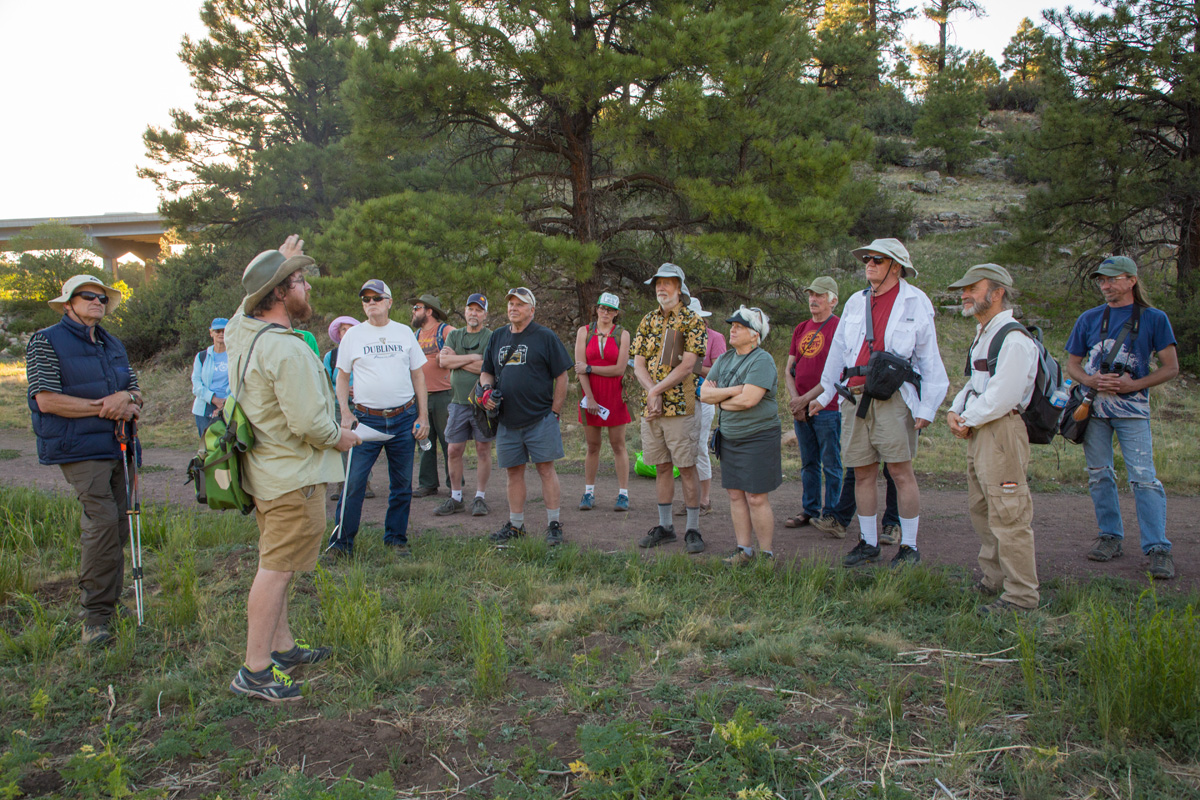
Michael Rotter, PhD candidate at Northern Arizona University, leads a guided hike at the Rio (I-40) wetlands on urban ecology. All photos courteous of Tom Bean Photography.
Thank you to all the hikers who joined us last night, Thursday, June 7th, at the Rio (I-40) wetlands! We hope to have you along again for the rest of our hikes that will occur this summer each month.
Thanks also to Michael Rotter, PhD candidate at Northern Arizona Universtiy, and Allen Haden, aquatic ecologist with Natural Channel Designs, for leading this informative hike.
All hikes are posted to this website and our Facebook page. Please consider signing up as a member (it’s free) to receive notifications about hikes directly to your inbox.

The Rio Wetlands as seen from a high point in Flagstaff, Arizona. Photos courteous of Tom Bean Photography.
Guides: Michael Rotter, NAU PhD Candidate; Allen Haden, Natural Channel Designs
Date: Thursday, June 7th at 5:30pm
Where: Meet at southwest corner of Sam’s Club Parking Lot
The Rio Wetlands as seen from a high point in Flagstaff, Arizona. Photos courteous
of Tom Bean Photography.
Urban wetlands support an incredible variety of plant and wildlife species while
also providing recreationists with a chance to enjoy nature within city limits.
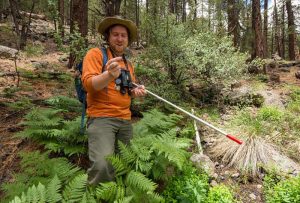
Mike Rotter examines an insect at Leroux Springs during his 2016 field season.
On Thursday, June 7th we will uncover the often overlooked world of urban ecology
through a guided hike at the Rio (I-40) Wetlands with Michael Rotter. As a PhD candidate
at Northern Arizona University, Michael studies plant-insect interactions through
the lens of an evolutionary ecologist. On Thursday, Michael will discuss the importance
of urban wetlands in supporting habitat for local flora and fauna.
Co-leading the hike will be Allen Haden, aquatic ecologist at Natural Channel Designs, who will provide insight about the unique hydro-geomorphological characteristics of wetlands. Allen will shed light on how local communities build and sustain wetlands in Arizona for a range of purposes beyond wildlife habitat. Allen currently serves as a Board Member with the Friends of the Rio.
We look forward to seeing you next week for a great hike! Meet at 5:30pm at the
southwest corner of the Sam’s Club parking lot.
We are suggesting a $5/participant donation for this guided hike.
THANK YOU to the great crew that joined us on Saturday to conduct the FIRST EVER flow monitoring event of the Rio de Flag! Your efforts provide the first step towards building a better understanding of flow in our river which is important for local natural resource managers.

Flow Monitoring Crew poses at Frances Short Pond before heading out to collect data along the Rio de Flag on May 19th, 2018.
Stay tuned for a blog post on the event.
Arizona Daily Sun • May 15th, 2018 • Emery Cowan

Large trenches filled with logs and small boulders help to collect sediment and slow down water as it rushes down the slopes burned by the 2010 Schultz Fire. About one third of the flood mitigation work was funded by Coconino County’s Flood Control District. Taylor Mahoney/ Arizona Daily Sun
City of Flagstaff residents could see a new addition to their property tax bills as early as this fall, and it won’t be something they or their city council voted for.
The Coconino County Board of Supervisors will vote Tuesday on a resolution to reverse a longtime interpretation of county ordinance that exempted citizens of Flagstaff, Page and Fredonia from taxation by the county’s flood control district.
What that means is when property tax bills go out in October, the owner of a $300,000 home in Flagstaff could find an additional $55 line item on their property taxes to pay for regional flood control projects.
The same goes for those who own homes, land and businesses in Page and Fredonia.
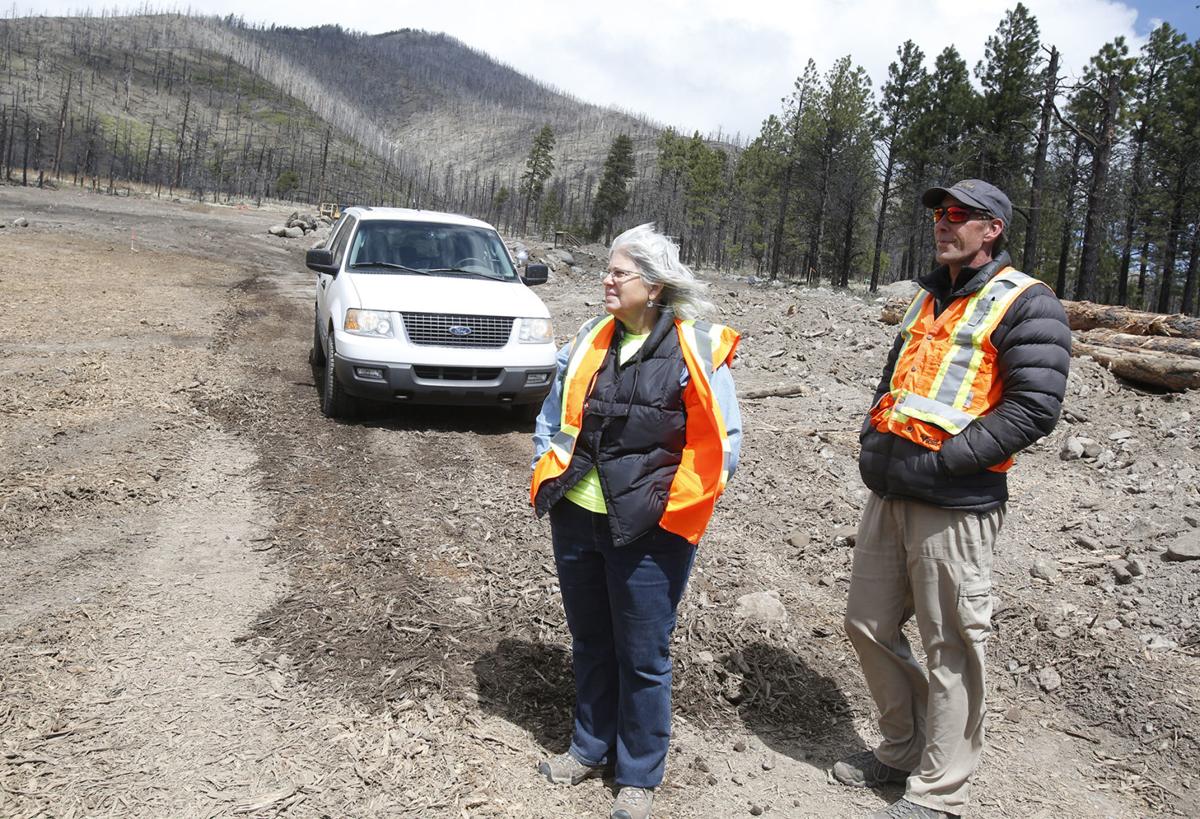
Coconino County Deputy Director of Public Works, Lucinda Andreani, left and James Guidotti, Coconino County capital projects manager, stand at the foot of one of the county’s flood mitigation projects in the Schultz fire burn area. The county’s flood control district funded about one third of the flood mitigation projects with the rest of the funding coming mostly from federal sources. Taylor Mahoney/ Arizona Daily Sun
Property owners of those three municipalities have been included in the county’s flood control district but exempt from taxation since the mid-1980s, when the district was created. An interpretation of the ordinance that created the district determined that those municipalities, because they each decided manage their own floodplains, could remove themselves from the district for the purpose of taxation, said Lucinda Andreani, interim deputy county manager and director of the public works department, which oversees the district.
But new advice from legal counsel hired by the county is that the flood control district tax should be levied upon all residents of the county, even if they live in cities that have elected to manage their own floodplains and have the ability charge residents additional stormwater fees to do so.
In short, cities and towns don’t have the “opt out” option that the county thought they did, Andreani said. That new interpretation also aligns with a requirement in state law that counties uniformly tax private properties within a jurisdiction, she said.
While the change will mean higher taxes for some, county residents who were paying the flood control district tax will see their bill drop. Andreani explained that the board of supervisors, which acts as the Flood Control District Board of Directors, are unlikely to increase the district’s $2.2 million budget in the short term, so when that total amount is spread out among more taxpayers, each property owner will pay less.
The current tax rate is 40 cents per $100 of assessed property value and is predicted to drop to 18.22 cents per $100 of assessed property value if the district’s $2.2 million budget is not increased.
Judging from assessed values in the county, tax revenues from Flagstaff property owners will make up more than half of the district’s total budget with the change, said Mike Townsend, deputy county manager.
Expanding the number of properties within the district’s tax base also significantly increases the total amount of money it can collect from property owners before hitting the state-mandated cap of 50 cents per $100 of assessed property value.
The board still has the option to take advantage of that expanded capacity and increase the flood control district’s budget for the upcoming fiscal year, which starts in July, Andreani said. But more likely is that the board will keep the budget the same for this year, spend several months talking with cities and towns about potential changes to the tax rate and what projects it could fund, then increase the flood control district’s budget if needed, she said.
In talking to the cities of Page and Flagstaff and the town of Fredonia, Andreani said they understand the legal dilemma the county faces but are concerned about raising taxes within their jurisdictions.
On the plus side, broadening the district’s tax base provides an opportunity to complete additional flood control projects, she said.
In an email statement, city of Flagstaff spokeswoman Jessica Drum said, “The City of Flagstaff was recently made aware of the County’s proposal related to the Flood Control District. We have raised a number of questions to help gauge the County’s plans for public involvement and the potential impacts on the city’s operations and programs and to property owners within the city’s jurisdictional limits.”
Because it is countywide, the district is charged with funding projects that have regional benefits, rather than city-specific impacts. Recently, that has included hiring a forest restoration director to help speed up large-scale forest thinning projects deemed crucial to preventing catastrophic wildfires and post-fire flooding in the region. District funds are also going toward a floodplain project for Mountain Dell, weed mitigation in the area of the Schultz Fire and the development of a pre-disaster plan for the city of Williams in the event of wildfire and post-fire flooding on Bill Williams Mountain, Andreani said.
In the aftermath of the flooding that followed the Schultz Fire in 2010, about $11.2 million of the $30.1 million spent on flood mitigation came from the county district.
In Flagstaff, taxpayers have spent about $15.5 million on flood mitigation for the Rio de Flag project. The Army Corps of Engineers, which will take on the largest financial burden for the project, has spent about $25.2 million so far of what is estimated to be a $106 million project. The remaining cost to the city is about $30 million.
While the county is “pretty confident” that its move to extend flood control district taxation countywide is legally correct, it’s also hoping that one of the municipalities takes the issue to court and asks for a final determination from a judge, Andreani said. That would provide legal clarification not only for Coconino County but also the state’s 14 other counties, all of which have flood control districts and a similar taxing scheme, she said.
The flood control district’s budget, which directly affects property owners’ tax rates, will go through a public hearing in June when the board of supervisors approves the final county budget.
News article available online at AZ Daily Sun.
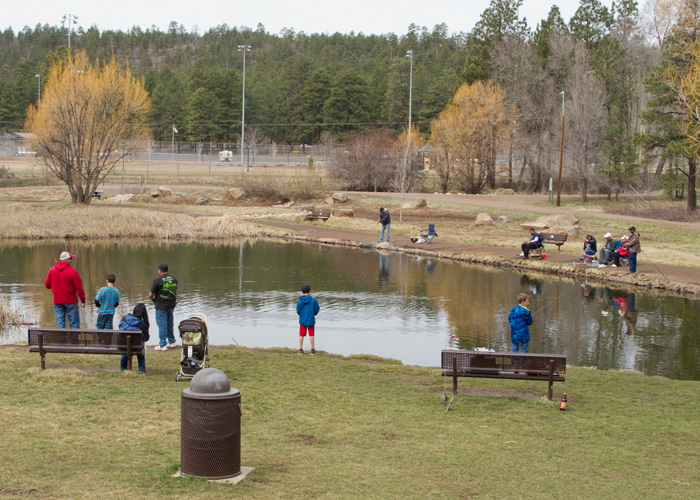
People fishing and enjoying the water at Frances Short Pond along the Rio de Flag, Flagstaff. Photo courteous of Tom Bean Photography.
When: Thursday, May 3rd, 6pm-7:30pm
Where: Montoya Community Center, 245 N Thorpe Rd, Flagstaff, AZ 86001
Description: What are your experiences with the Rio de Flag? How often do you cycle or walk your dog on the FUTS that parallels the Rio? What are the benefits the Rio provides and some of its issues?
Join us on Thursday, May 3rd as we hear from Chelsea Silva, Executive Director with Friends of the Rio, who will share results from a survey of Flagstaff Area residents’ experiences with the Rio de Flag.
Friends of the Rio partnered with the City of Flagstaff and Coconino County to release this survey on the City’s Peak Democracy platform. Over 200 residents provided input through comments and placing points on a map to show recreation and restoration needs throughout the watershed.
Thank you to the Arizona Community Foundation for supporting this project!
Chelsea earned her Masters in Environmental Sciences & Policy from Northern Arizona University in 2016. During her studies, she began volunteering with the Friends of the Rio. She currently serves as an AmeriCorps STEM VISTA with the organization, working to build capacity through fundraising, partnership building, and event coordination.

 Private Wells: Water Regulation, Perched Aquifers and Septic Impacts
Private Wells: Water Regulation, Perched Aquifers and Septic ImpactsPlease click here to view the original press release.
FLAGSTAFF, Ariz. – The Coconino Plateau Watershed Partnership (CPWP), the United States Geological Survey (USGS), Coconino County and County Supervisor Art Babbott are hosting a community forum, “Private Wells: Water Regulations, Perched Aquifers and Septic Impacts,” on May 16. The meeting will inform private well owners across Coconino County on how to better understand the relationship between private wells and septic systems in the region and how to protect their wells from contamination.
There will be presenters from the State of Arizona Department of Environmental Quality, the Department of Water Resources, Northern Arizona University, USGS and others to discuss the responsibilities of the State and County regarding people’s water supplies.
Specific questions may be submitted ahead of time using the “Contact Us” link on the Coconino Plateau Watershed Advisory Committee website www.cpwac.org. The link is located on the lower right of the Home Page. Questions should be submitted prior to Thursday, May 10 so they can be distributed to the presenters.
Attendees will also receive a copy of the Arizona Well Owner’s Guide.
WHO: Free and open to members of the public
WHAT: Community Forum on Private Wells in Northern Arizona: Regulations, Perched Aquifers and Septic Impacts
WHEN: 6 – 8:30 p.m. May 16.
WHERE: United States Geological Survey Bldg. #3
2255 N. Gemini Dr., Flagstaff, Ariz., 86001
For more information, please call Ron Doba, CPWP Coordinator, at 480-299-5764.
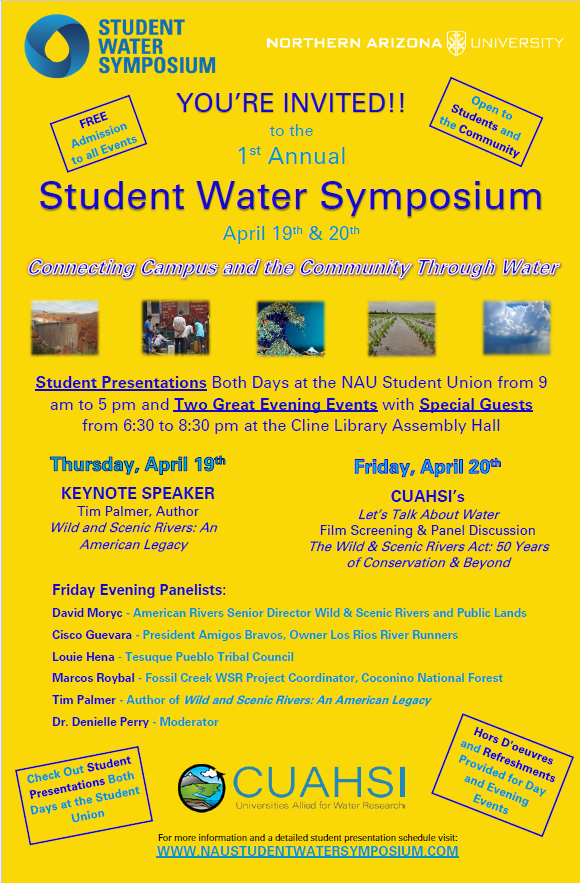
You are invited to Northern Arizona University’s First Annual Student Water Symposium on April 19th-20th. The event offers both graduate and undergraduate students at NAU an opportunity to present water-related research and collaborate across disciplines, shaping them as the next generation of water policy-makers, managers, and stewards.
Moreover, the symposium acts as a venue to connect campus and the greater Flagstaff community through water by offering two evening events centered around the theme: The Wild & Scenic Rivers Act: 50 Years of Conservation & Beyond.
Thursday evening features a talk and presentation by special guest, Tim Palmer, author of Wild and Scenic Rivers: An American Legacy. Friday evening presents a screening of three short films by American Rivers followed by a panel discussion with river conservation professionals.
Both evening events are free admission to the public and promise to enlighten and inspire the audience.
Please visit their website www.naustudentwatersymposium.com details regarding evening events, a detailed list of featured panelists, and the student presentation schedule.
Hors d’oeuvres will be available at all events.
###